We have raised chickens in cold north winters for over a decade now and have learned just how hardy chickens really are.
Chickens can survive cold winters with a sturdy coop, high-energy feed, and access to unfrozen water. Without good coop ventilation, chickens are prone to winter pneumonia and death. In extreme cold, insulation and indirect heat may be needed to keep chickens alive.
There is a lot to cover here. I’ll go over everything you need to know about keeping chickens in cold weather.
Raising Chickens in Cold Winters
Cold weather complicates everything and keeping chickens is no different. There is a set of concerns that cold weather brings to the chicken owner. If you’re new to cold weather yourself, don’t panic. It’s going to be alright for your birds. Sure, there are a few things to think about, but it’s fairly simple.
The primary concern people have for their chickens during the winter months is the cold temperatures affecting the chickens. Honestly, that’s the least of my concerns in northern Michigan. There are secondary concerns the cold brings with it that tend to cause worse problems for chickens.
There are potential issues with humidity and moisture buildup causing all sorts of troubles. There are potential issues caused by shorter, or uneven daylight hours, and even some changes in required nutrition during the winter months. It may sound harsh, but I assure you most chickens will be fine.
The biggest thing you can do to help your chickens stay warm and happy in cold weather is to keep their coop bone dry. Make sure that there aren’t any leaky spots in the roof or walls where snow or melting ice can easily get inside. That’s bad for two reasons.
The first reason is that chickens are warmer if dry. Dry feathers will fluff better and insulate much more efficiently. Here we have the principles of heat transfer at work. The cold air will draw away a chicken’s body heat, but that’s not generally a problem. That’s called convection, or heat transfer by air.
The issue comes from a bird being wet. Water is more solid than air, so it gets into the area of conduction. Heat transfers over twice as easily through conduction than through convection. That means that if a chicken is wet, it’s like the temperature is twice as cold to the bird.
Now, most people understand that well enough. If the bird’s feathers look wet, see that they can dry off soon. If they are wet and it’s very cold out, you may want to bring them inside to give them a chance to warm up and dry off.
A dirty coop often is quite wet. Coop litter becomes waterlogged from chicken manure and from snow being tracked onto the coop floor. A very wet coop floor will eventually make chickens wet top to bottom if not cleaned up. Keep that coop clean and dry. Your chickens will thank you wholeheartedly.
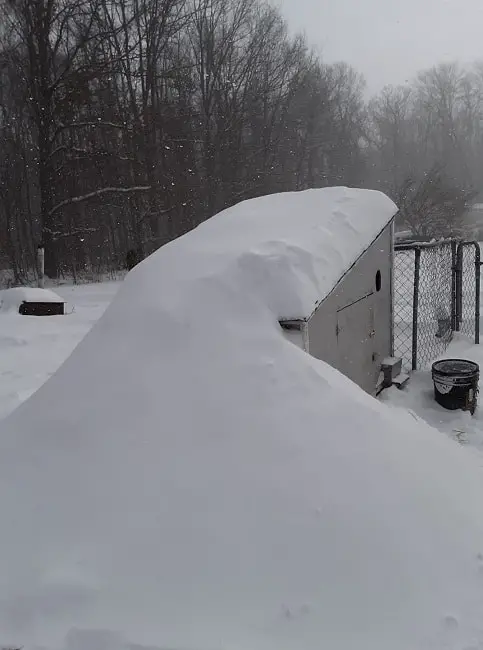
Proper Ventilation for a Winter Chicken Coop
Besides the actual accumulation of water in your coop, there are potential issues with moisture. A high level of moisture will also steal the warmth away from a chicken’s core quicker. More humidity means the chicken has to work harder to keep up its internal temperature of 105 degrees.
The harder a chicken works to keep up its temperature, the more stressed it will be. And that’s what causes most of the problems with chickens; with people too. We’ve gotta do what we can to keep the stress levels down for healthy animals.
Ventilation is the biggest deal to get right in a chicken coop, any time of year. But it’s more important in winter. You want to limit the severity of cold drafts blowing on your roosting chickens. Winter wind is a stress increase for all animals, for you too. If your coop is too cold, cut down on the drafts.
10 chickens in a small coop will noticeably raise the temperature a good 10 degrees if there isn’t a big draft problem. You want to have only enough airflow to keep the humidity and stale air circulating out. Honestly, with 10 chickens in a coop, a silver dollar-sized hole for airflow is enough.
Too much airflow and your chickens may have a hard time keeping warm. You probably have a small door near the bottom of the coop for them to come and go. A small hole in the top will cause circulatory venting and keep a small amount of air cycling in and out, but not too much.
If you are keeping your coop fairly clean and notice a heavy smell of ammonia, you’ll probably want a little more airflow. Consider leaving a door or window slightly ajar during the day, or you can just drill an extra hole as I did.
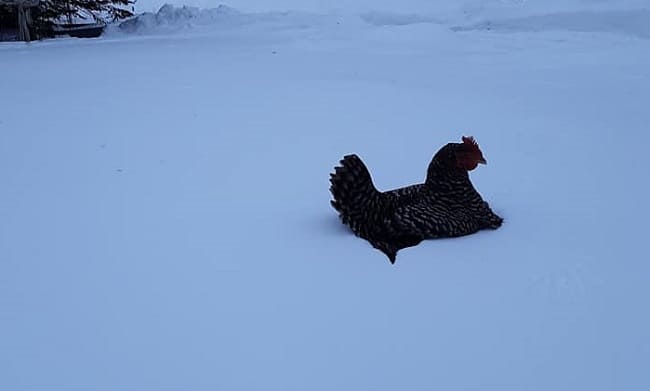
Do Chickens Need Heat in the Winter?
Chickens do not need any supplemental heat in the winter except in extreme environments. With cold hardy chickens, and in temperatures warmer than 40 below zero, it should never be needed. In fact, adding a heat lamp or heating pad can cause problems for your flock.
Chickens don’t handle shock very well. they are quite sensitive to sudden changes in their environment. Chickens are also very good at acclimating to a slowly changing environment. Having a coop heated to 60 degrees while it’s 30 degrees outside will cause a lot of stress on them.
Their bodies and metabolism will not acclimate to the cold weather with higher energy needs. A heated coop will cause then to stay inside all day which reduces the exercise they get, and causes more moisture buildup in the coop.
Chickens don’t need a heat lamp, heating pad, or any other heating device except in near arctic areas.
The down feathers on a chicken are amazing insulation to keep their body heat in. Chickens with thick plumage and small combs will not have an issue in most winter temperatures.
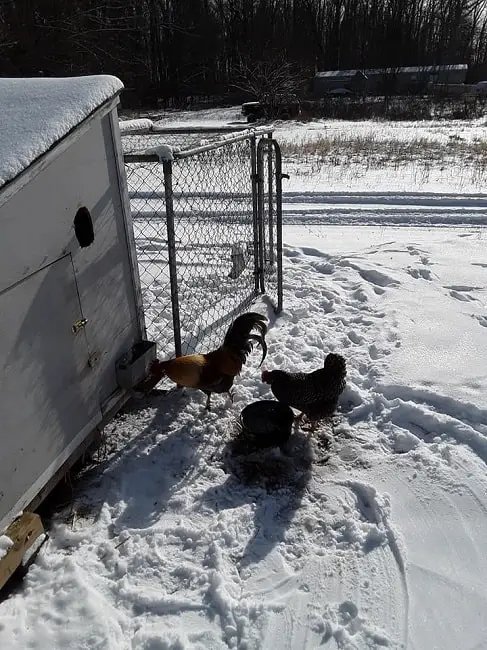
How Cold Can Chickens Survive?
Cold hardy chickens can handle -30 degrees in the coop. colder than that and you’re getting into arctic weather. That’s a whole different game up there.
In arctic weather, chickens are more appropriately housed in a barn with a wood stove to keep it from attaining ridiculously low temperatures. My chickens handle -20 degrees with only slight stress. That’s because generally is an extreme temperature swing during a winter storm.
If it were a more common temperature, it wouldn’t have any effect on my birds. Just because it’s generally a quick, short-term drop, they don’t get used to it. I have friends in Alaska who have kept chickens in -40-degree weather just by building their coop near their chimney for heat.
Chickens are very resilient and are built to handle things much harsher than we are. That’s good because they certainly don’t have the brains we do.
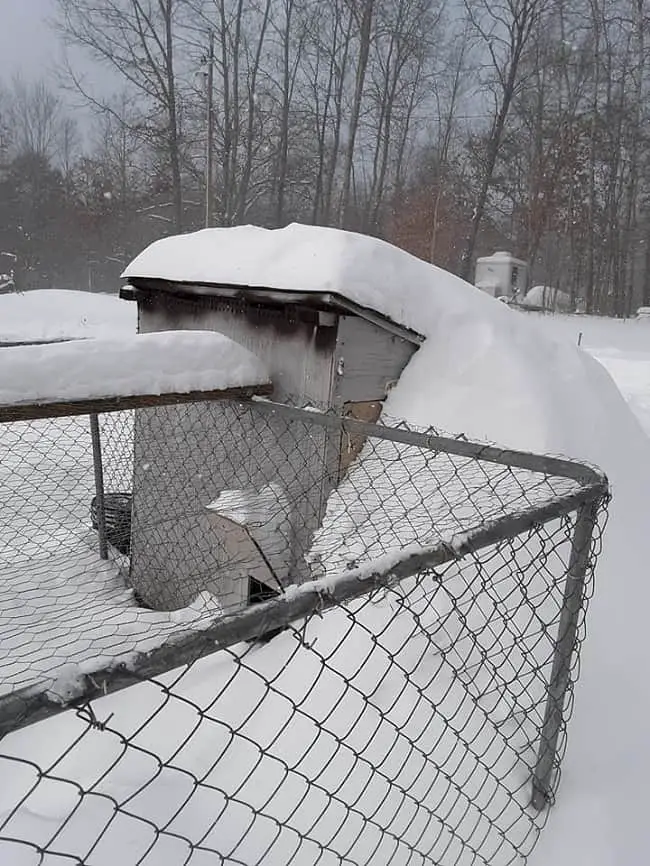
Should I Insulate my Chicken Coop?
In all my years, I don’t think I’ve ever heard of anyone insulating their chicken coop around here. Not that there’s anything wrong with doing it. Insulating a coop would help it to stay warm in the winter and cool in the summer. It would also reduce the sound of those midnight crowing sessions.
Chickens don’t need winter insulation on their coop. however, since it helps to maintain an even temperature, it would help to reduce the stress on a flock. Stress is the biggest factor in egg production.
If you are trying to keep your hens laying eggs in the winter, I’d look into insulation options. For a hen to lay consistently, the environment has to be consistent.
One of the most efficient ways to insulate a coop is to use foam board. Foam board is a 4×8 foot sheet of stiff foam. It will cover a coop and can be attached with screwed or nailed on to most coops pretty easily. I talked to a man from Fairbanks, Alaska who insulates his coop with foamboard.
He put foamboard on, then covered it in thin plywood. Then he sealed the edges with calk. Of course, he made sure it had adequate ventilation too. Insulation generally keeps coops 10 degrees warmer than the outside temperature. It helps to hold in the heat produced by the chickens.
Winter Feed for Chickens
In the winter, chickens need more energy to keep up with their increased metabolism. You can feed them more of their regular feed, or add high-energy, high-protein feed elements to the food bowl. If hens aren’t laying eggs, it may be wise to swap their high-calcium layer feed for a basic feed.
Standard chicken feed will probably be fine to feed in the winter months. You need to be sure that the chickens get enough to feed. Body heat is created by cells releasing energy. The only way to replenish that energy is with food. In cold weather, chickens need either more feed or higher calorie feed.
The standard high-calorie feed options are grains and sweet feed. Which grain you use depends on what’s available in your area. Around me, we use either cracked or whole corn. Millet, barley, and milo are other grains that might be available locally. Cracked, roasted, or rolled grains will offer more energy.
Whole oats can actually be harmful to chickens. There are chemicals in the germ of oat that can reduce the absorption through digestion by up to 30 percent. Oats without the hull are fine. Any sweet feed or sweet grain can also be used. Sweet implies that there is molasses added for minerals and energy.
Generally, you shouldn’t supplement more than 1/3 of a chicken’s diet with a single grain. I can certainly see a case for up to a 50/50 ratio of chicken feed/energy supplement diet in extreme cold situations. With the sweet feed or sweet grains, you could feed them entirely for a time.
I feed my chickens mainly cheap sweet feed in the winter months. They don’t need a laying diet with high calcium and protein in the winter, so I go with a cheaper, higher-calorie option to cut costs and help get them through winter.
Watering Chickens in the Winter
Chickens need more water in the winter as their feed consumption increases. Water in the winter is hard to deal with: it’s a constant struggle. Water bowls generally freeze, sometimes within minutes. If your chickens aren’t getting enough water, they will also slow down their food intake.
You can use heater water bowls, and they are nice for some people. For us, the extra electricity bill isn’t worth the convenience. Water bowls can be brought inside and allowed to thaw out for later use. A common method is to water them in the morning and bring the bowls inside after they freeze over
If the water freezes over within minutes, you’ll need to have fresh water available to the flock at least twice in a day. A thirsty chicken can drink a day’s worth of water in 3 minutes, so don’t be too upset if the water freezes soon after you put it out.
If it’s freezing temperatures, don’t put out the water until the chickens are all out of the coop in the morning. It may freeze before they can get to it. in freezing weather, I have to skip watering the chickens in my before-work chores. My wife will put it out after sunup.
Don’t underestimate the power of ice either. As it freezes, it expands. We’ve lost several crocs and a metal water bowl from expanding ice. Non-brittle plastics and rubber buckets are great for winter water bowls. Plastic Ice cream pails work well and don’t get brittle when frozen.
With the black rubber bowls, I can flip them upside down and kick the ice right out, which makes it easy to refill them. I use those a lot around here. If you use a metal bowl it better be stout, otherwise, the repeated freezing will eventually cause them to crack.
If snow and ice completely cover the ground, chickens may need a source of grit. You can buy crushed oyster shells or other similar grit for them, or you can be much more practical. There is a pail of dirt in my shed that I can use for a natural grit if they need it. Without grit, they can’t digest food properly.
Related Articles:

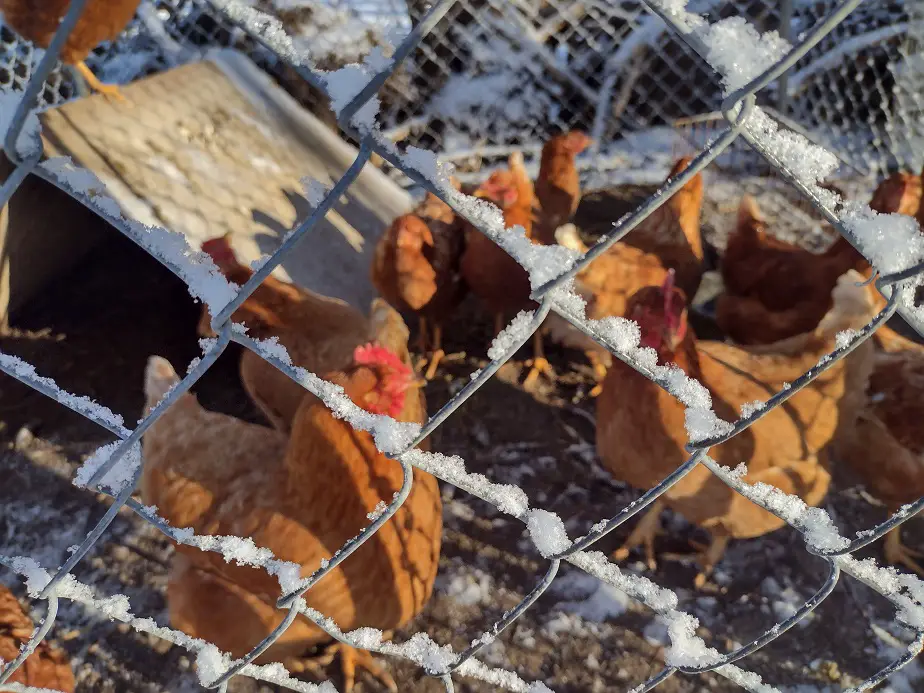
Thanks for your blog, nice to read. Do not stop.